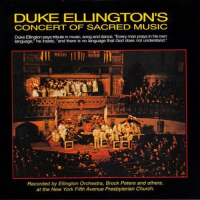Home » Jazz Musicians » Paul Gonsalves
Paul Gonsalves
Although his reputation is often hung upon the mighty gallery-rousing performance he gave at the 1956 Newport Jazz Festival with Duke Ellington, tenor saxophonist Paul Gonsalves was at heart an introspective balladeer. His true legacy is his recorded collection of love songs.
Paul Gonsalves was born on 12 July 1920, in Boston, Massachusetts, which is where he had his first professional engagement. He played tenor saxophone with the Sabby Lewis band for several years, a stretch split by military service during World War Two. In 1946, he left the Lewis band to join Count Basie for almost three years, was briefly with Dizzy Gillespie in 1949, and then joined Duke Ellington in 1950. He was to remain with Ellington for the rest of his life. In common with many other tenor players who aspired to play with Ellington, Gonsalves learned Ben Webster's famous 'Cottontail' solo note for note, but it was not long before his own distinctive style thrust aside imitation.
By the time of his sixth year with Ellington, Gonsalves had experienced the ups and downs of playing with a big band. Gonsalves was building a reputation as a consummate balladeer and also as a crowd pleaser thanks to Ellington's choice of him as the soloist to bridge the opening and closing sections of 'Diminuendo and Crescendo in Blue'. He had already done this on some dance dates when Ellington called this number at the 1956 Newport Jazz Festival. It had been a mixed night; Ellington was irritated by his placing on the bill, the show was a long one and the audience was already drifting homewards, and some of the band had been more than usually tardy in returning to the stand after the interval. Whatever the truth behind the moment, the fact is that Ellington called this number, the band played the opening section, and then Gonsalves stepped forward and began to play. And he played and he played and he played. His storming, 27-chorus bridge dragged the audience back to its seats. The band had already been playing well and everyone was in marvelous form and enjoying the occasion. Now, stoked by Sam Woodyard's drumming and the leader's jabbing chords from the piano, they transcended all that had come before on that night and much of what had transpired in the quarter century of the band's existence. A legend was born.
The astonishing impact on the audience present that night was imparted to the world, thanks to suddenly focused media attention. This was the start of Ellington's renaissance and neither he nor Gonsalves ever looked back. The down side was, inevitably perhaps, that the saxophonist was obliged to play extended gallery-pleasing, up-tempo solos every night, a fact which overshadowed his great love for ballads.
Read moreTags
Duke Ellington's Concert of Sacred Music

by Chuck Lenatti
In 1964, Dean D.J. Bartlett and the Reverend John S. Yaryan invited Duke Ellington and his orchestra to present a concert to consecrate the renovated Grace Cathedral on Nob Hill in San Francisco during a year-long festival of Grace. At first, Duke demurred. In his autobiography, Music Is My Mistress (Da Capo, 1976), Ellington explained why he changed his mind: It has been said once that a man who could not play the organ or any ...
Continue ReadingDuke Ellington: Copenhagen 1958

by Ken Dryden
Duke Ellington left a formidable discography at his death at the age of 75 in 1974, and it has expanded greatly with the number of concerts that have been uncovered and issued since then. This CD is drawn from two 1958 concerts at KB Hallen in Copenhagen, though they are not sourced from the original, long lost broadcast tapes, but dubs evidently made by a fan. What makes this a valuable find is that the band is in top form ...
Continue ReadingDuke Ellington: Copenhagen 1958

by Jack Kenny
Duke Ellington hated flying so, in 1958, Ellington and Co sailed into Southampton UK to prepare for a tour of Europe. Before going on to Copenhagen, Ellington completed a tour of the UK, taking in Leeds where he met Queen Elizabeth, an event which eventually resulted in the “Queen's Suite." Earlier in the year, his strange obsession with royalty had produced a piece for Princess Margaret, “Princess Blue'" The band was particularly strong in this part of its ...
Continue ReadingPaul Gonsalves @ 100 And More July Birthdays

by Marc Cohn
Time to celebrate July birthdays! Among the living, David Sanborn @ 75, pianist Mark Soskin, trumpeter Theo Croker, Kenny Burrell and Ahmad Jamal @ 90! We celebrate the saxophonists: Paul Gonsalves @ 100 and Hank Mobley @ 90. Along the way, birthday salutes to Philly Joe Jones, Lee Morgan, Charlie Christian, pianist Billy Taylor and Johnny Hodges. Enjoy the show! Playlist Hank Mobley “Soul Station" from Soul Station (Blue Note) 00:00 Hank Mobley “Old ...
Continue ReadingDiminuendo and Crescendo

by Mitch Myers
This excerpt appears in The Boy Who Cried Freebird: Rock & Roll Fables and Sonic Storytelling (Harper Paperbacks, 2008).I tried calling my good pal Harlan the other day. I needed some help with my computer and if anyone knows about computers, it's Harlan. Unfortunately, or perhaps fortunately, my friend was nowhere to be found. Instead, Harlan's voicemail greeting confronted me.“Hi, I'm not home right now," his voice explained. “This is Paul Gonsalves' saxophone solo from 'Diminuendo ...
Continue ReadingJazz Musician of the Day: Paul Gonsalves

Source:
Michael Ricci
All About Jazz is celebrating Paul Gonsalves' birthday today!
Although his reputation is often hung upon the mighty gallery-rousing performance he gave at the 1956 Newport Jazz Festival with Duke Ellington, tenor saxophonist Paul Gonsalves was at heart an introspective balladeer. His true legacy is his recorded collection of love songs. Paul Gonsalves was born on 12 July 1920, in Boston, Massachusetts, which is where he had his first professional engagement. He played tenor saxophone with the Sabby Lewis band ...
read more
Jazz Musician of the Day: Paul Gonsalves

Source:
Michael Ricci
All About Jazz is celebrating Paul Gonsalves' birthday today!
Although his reputation is often hung upon the mighty gallery-rousing performance he gave at the 1956 Newport Jazz Festival with Duke Ellington, tenor saxophonist Paul Gonsalves was at heart an introspective balladeer. His true legacy is his recorded collection of love songs. Paul Gonsalves was born on 12 July 1920, in Boston, Massachusetts, which is where he had his first professional engagement. He played tenor saxophone with the Sabby Lewis band ...
read more
Jazz Musician of the Day: Paul Gonsalves

Source:
Michael Ricci
All About Jazz is celebrating Paul Gonsalves' birthday today!
Although his reputation is often hung upon the mighty gallery-rousing performance he gave at the 1956 Newport Jazz Festival with Duke Ellington, tenor saxophonist Paul Gonsalves was at heart an introspective balladeer. His true legacy is his recorded collection of love songs. Paul Gonsalves was born on 12 July 1920, in Boston, Massachusetts, which is where he had his first professional engagement. He played tenor saxophone with the Sabby Lewis band ...
read more
Paul Gonsalves: '54 and '57

Source:
JazzWax by Marc Myers
Yesterday, I posted on tenor saxophonist Paul Gonsalves and one of his late-career albums with piano wizard Earl Hines. Today, I want to give you a sense of how spectacular Gonsalves was on recordings in 1954 and '57. On the scale of playing styles, I'd put Gonsalves somewhere between Don Byas and Lucky Thompson, with Byas's puffy smoke-stack sound and Thompson's eely yearning. But to be fair, Gonsalves had his own thing, marinated by his years nestled in Duke Ellington's ...
read more
Paul Gonsalves Meets Earl Hines

Source:
JazzWax by Marc Myers
Tenor saxophonist Paul Gonsalves's centenary was over the weekend, on July 12. A romantic balladeer and gruff hard-charger, Gonsalves spent much of his career in the Duke Ellington Orchestra from 1950 onward. On his small-group leadership and sideman sessions, Gonsalves often was paired with tiger musicians who could rise to the occasion and give as good as they got. Album mates included Clark Terry, Tubby Hayes, Sonny Stitt and Eddie “Lockjaw" Davis. One of the rare non-horn match-ups was Paul ...
read more
Jazz Musician of the Day: Paul Gonsalves

Source:
Michael Ricci
All About Jazz is celebrating Paul Gonsalves' birthday today!
Although his reputation is often hung upon the mighty gallery-rousing performance he gave at the 1956 Newport Jazz Festival with Duke Ellington, tenor saxophonist Paul Gonsalves was at heart an introspective balladeer. His true legacy is his recorded collection of love songs. Paul Gonsalves was born on 12 July 1920, in Boston, Massachusetts, which is where he had his first professional engagement. He played tenor saxophone with the Sabby Lewis band ...
read more
Jazz Musician of the Day: Paul Gonsalves

Source:
Michael Ricci
All About Jazz is celebrating Paul Gonsalves' birthday today!
Although his reputation is often hung upon the mighty gallery-rousing performance he gave at the 1956 Newport Jazz Festival with Duke Ellington, tenor saxophonist Paul Gonsalves was at heart an introspective balladeer. His true legacy is his recorded collection of love songs. Paul Gonsalves was born on 12 July 1920, in Boston, Massachusetts, which is where he had his first professional engagement... Read more.
Place our Musician of the Day widget ...
read more
Jazz Musician of the Day: Paul Gonsalves

Source:
Michael Ricci
All About Jazz is celebrating Paul Gonsalves' birthday today!
Although his reputation is often hung upon the mighty gallery-rousing performance he gave at the 1956 Newport Jazz Festival with Duke Ellington, tenor saxophonist Paul Gonsalves was at heart an introspective balladeer. His true legacy is his recorded collection of love songs. Paul Gonsalves was born on 12 July 1920, in Boston, Massachusetts, which is where he had his first professional engagement... Read more.
Place our Musician of the Day widget ...
read more
Jazz Musician of the Day: Paul Gonsalves

Source:
Michael Ricci
All About Jazz is celebrating Paul Gonsalves' birthday today!
Although his reputation is often hung upon the mighty gallery-rousing performance he gave at the 1956 Newport Jazz Festival with Duke Ellington, tenor saxophonist Paul Gonsalves was at heart an introspective balladeer. His true legacy is his recorded collection of love songs. Paul Gonsalves was born on 12 July 1920, in Boston, Massachusetts, which is where he had his first professional engagement... Read more.
Place our Musician of the Day widget ...
read more
Tubby Hayes + Paul Gonsalves

Source:
JazzWax by Marc Myers
Today I want to share with you two albums that are so rare they'll likely come as a surprise to even the most knowledgeable jazz fans. The albums—Just Friends and Change of Setting— paired British saxophonist Tubby Hayes with Ellington saxophonist Paul Gonsalves. Just Friends was recorded in 1964, while Change of Setting was recorded a year later but not released until 1967. They are superb and grow on you with each listen. How did Hayes and Gonsalves wind up ...
read more







































